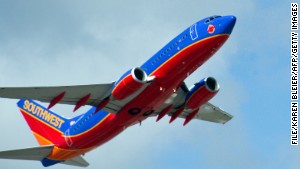Editor's note: Robert Goyer is the editor-in-chief of Flying magazine.
(CNN) -- After a Boeing 747 Dreamlifter landed at a small airport in Wichita a couple of months ago -- the pilot having mistaken the runway for a much longer and wider one in a similar orientation at a nearby military base -- I made the prediction that it wasn't the last time we'd see such a blunder.
I just didn't think it would happen again so soon.
But on Sunday, a Southwest 737 crew mistook a runway in Branson, Missouri, for one at the much larger airport nearby, Springfield/Branson National Airport, and landed there instead. To make matters more hair-raising, the 737 touched down on a relatively short runway even for light planes, never mind for airliners. To their credit, the crew members of the Boeing jet got it stopped short of the end of the runway, where an embankment separated it from U.S. Highway 65, without doing any damage to passengers or the plane.
 Robert Goyer
Robert Goyer The question arises: "How did a professionally trained crew manage to screw up so badly?" The answer is it's very easy to do. Take the accidental landing of a C-17 at a small Florida airport in 2012, for example. The crew's intended airport was MacDill Air Force Base, but it instead touched down the giant jet on the much, much shorter, 100-foot-wide runway a few miles away. Military personnel had to work for hours after the mix-up to lighten the airplane's load so it could take off from the short strip.
The fact is that any pilot with a lot of experience who claims to have never at least lined up to land at a runway other than the intended one is probably fibbing. I've been flying everything from light propeller planes to big jets for more than 30 years, and I've aimed for the wrong runway three times and a really big taxiway on a different occasion.
The problem is there are two distinct modes of operating an airplane, by reference to the instruments and by visual reference. With very, very few exceptions, every flight ends with the pilot turning off the autopilot (if it was engaged), taking physical command of the plane through the flight and power controls, "acquiring" the runway visually and landing. Sometimes that process happens in the last 10 seconds of a flight, sometimes in the last five minutes.
 Plane lands at wrong airport
Plane lands at wrong airport  Plane lands at wrong airport
Plane lands at wrong airport  Plane lands at wrong airport
Plane lands at wrong airport It's that visual acquisition of the landing runway that's the trap. When pilots see what they believe is the right runway, they're going to land there unless some big alarm goes off in their head. It's simply human nature, and pilots are humans. They proceed to disregard the instruments and simply "hand fly" the airplane to a landing, that is if the co-pilot doesn't alert them to the flub.
All the while the navigation instruments "know" the plane is headed to the wrong airport, but the pilots don't pay attention because in their mind they've already found the right runway, so why even bother to look at the instruments?
Why don't more of these wrong airport episodes end in disaster? It's luck that most of them don't. Tragically, there are exceptions. In 2006, a regional jet took off from the wrong runway in Lexington, Kentucky. The runway was too short and the jet crashed, killing 49 people in the process.
Landing at the wrong airport or choosing the wrong runway can be catastrophic.
Had the 747 in Wichita tried landing on a runway as short as the one the much smaller 737 touched down on over the weekend, I don't think it could have stopped in time to avoid going off the end and at the very least wrecking the airplane. Modern airliners have two things going for them — great brakes and powerful reverse thrusters — and in the case of both the 737 and the 747 before it, it was a good thing they did. I wasn't there to witness either event, but I'd be shocked if the smell of superheated brake pads wasn't in the air.
Follow us on Twitter @CNNOpinion.
Join us on Facebook/CNNOpinion.
{ 0 comments... read them below or add one }
Post a Comment